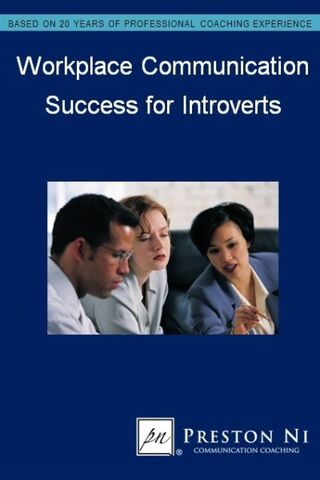Introversion
7 Keys to Establishing a Confident Impression
How to present yourself at your confident best!
Posted January 12, 2014

When you meet others, do you make a strong and confident impression? Is the way you project yourself assertive or weak, impressive or forgettable? In interview situations, an interviewer typically determines whether you’re a good candidate for the job within 6 seconds of meeting you (1). Socially, people often evaluate whether we should be treated as an equal, superior, or inferior based on our charisma (or lack thereof) and demeanor. What are some of the keys to establishing a confident first impression, whether you’re dating, socializing, interviewing, or business networking? Here are seven keys to presenting yourself at your best, with excerpts from my books (click on titles): "Relationship Communication Success for Introverts" and "Workplace Communication Success for Introverts".
1. Make Natural and Direct Eye Contact
“The Eyes are the windows of the soul.”
― Traditional proverb
Eye contact is the single most important body language in Western societies (different cultures have different norms for eye contact). Research reveals that patterns in the iris send signals which indicate whether we’re friendly or unfriendly, trusting or neurotic (2). Importantly, we use our eyes to convey attentiveness, rapport and trust. We can also use our eyes to establish authority, strength and power.
In most social and professional situations, the best way to make eye contact is to be natural and direct. Natural means looking at a person without staring. Direct means avoiding excessive eye movement sideways, which could be interpreted as evasiveness or distraction, or downwards, which could be viewed as insecurity and lack of confidence.
There are certain conflict situations where positioning yourself next to a person (or at an angle) and looking in the same direction may help de-escalate tension. In most positive or neutral situations, however, it’s useful to maintain natural and direct eye contact.
2. Show a Confident Smile
“You can only hold a smile for so long, after that it's just teeth.”
― Chuck Palahniuk
In any situation where you want to be taken seriously and treated with respect, show your confident smile. A confident smile is simply one that does not show too much teeth. Flashing too much of your ivories may give the impression that you’re eager to please and seeking approval. This tip only applies to situations where you want to be taken seriously. In more relaxed and informal situations, smile however you like.
In addition, a recent study by Kelton Research (3) suggests whether a person’s smile and teeth are straight or crooked can have significant impact on her or his romantic and career success. In the research, those with crooked teeth are viewed as less intelligent and accomplished than those with straight smiles. People with crooked teeth are also shown to be at a disadvantage when it comes to getting dates or jobs.
We all know that we should not judge a book by its cover, but people often do. Choosing orthodontic work is a personal decision, and in some cases it’s an investment worth making.
3. Offer a Firm Handshake
“The weak, horrible, wet fish handshake is a problem…gives a lot away.”
― Diana Mather

In most professional and certain social situations, a handshake is just about the only appropriate form of physical contact. Your handshake is your calling card. People “read” your handshake and can instantly determine whether you should be treated as an equal, superior, or inferior. The best way to shake hands, for both women and men, is to be firm. Offer enough strength in your grip to show that you’re confident, but not so much as to make the other person feel uncomfortable. When you give a firm handshake, you’re sending the signal that should be treated with respect.
4. Dealing with a Much Bigger and Taller Person
“Size matters not. Look at me.”
― Yoda
When facing someone who’s much bigger and taller, use any of the following tips to subtlety neutralize the height disadvantage:
A. Avoid lifting your head up when looking at a much taller person, which only makes you appear (and feel) smaller.
B. Interact sitting down instead of standing up to diminish the size differential.
C. Position your body at an angle instead of face to face to avoid being overwhelmed physically.
5. Use Diaphragmatic Voice
"The human voice is the organ of the soul."
― Henry Wadsworth Longfellow
Research by Albert Mehrabian at the University of California in Los Angeles shows that our tone of voice accounts for 38% of how we communicate our attitude and feelings (4). In my work as an organizational trainer and presenter, I identify voice as one of three non-verbal communication “signatures” (the other two are eye contact and handshake) where others may instantly judge you favorably or unfavorably by the way you express yourself. Many women and men underutilize their voice, much to their professional and social detriment. Our best sounding voice comes from the diaphragm. To learn how to access your strongest and most attractive voice, see my article: "How to Improve the Sound of Your Voice".
6. Dress for Success – Know Your Best Colors and Metal
“Clothes make the man (and woman).”
― Mark Twain
As mentioned earlier, we should not judge a book by its cover, but many people do. Our personal appearance contributes greatly to how we’re perceived and judged during face to face encounters. Research also indicates that our confidence can be influenced by the way we dress (5). You don’t need expensive clothes or name brands to make yourself look attractive. You simply need to know which combination of hairstyle, clothing colors, clothing style, and accessories make you look terrific. This principle applies to both women and men.
Here are just a few guidelines:
A. The best compliment you can receive about your appearance is not “I like your hair” or “I like what you’re wearing,” but “YOU look fantastic!” The best hair and wardrobe ensembles flatter YOU, without calling unnecessary attention to the individual pieces themselves.
B. Know the best color season for your clothes. Colors can be divided into spring, summer, autumn and winter groups. Depending on your hair color, eye color, and skin tone, there’s usually one season in which you look your absolute best (see photo). One key to putting together the most attractive wardrobe for yourself is by balancing your best seasonal colors with neutral colors.
C. Know your best metal. Most of us look good with either gold or silver color accessories, but few of us look good in both. Metallic color accessories can range from eye ware, earrings, bracelet, pin, tie, belt buckle to even a pen. Like your best seasonal color, the right metal makes YOU look elegant and charismatic, without drawing unnecessary attention to itself.
7. Confident Stance and Gestures
“A good stance and posture reflect a proper state of mind.”
― Morihei Ueshiba
According to a recent study published in Psychological Science, good posture directly helps us feel more confident (6). When we stand, walk or sit erect, we occupy more space while breathing deeper breaths, which in turn help us feel stronger and more solid. Similarly, our hand and arm gestures are an extension of our charisma. Gestures enlarge our physical presence, and help us become dynamic communicators (7).

A simple way to use gestures effectively is to imagine a circle around your upper body that extends to the left and right of your extended elbows, and the same length in front of your upper chest. Within this circumference, gesture circularly outward with one or both arms (see photo).
In conclusion, it is said that “you never have a second chance to make a good first impression.” This is true whether you meet somebody for the first time, or someone whom you already know for the first time today. By using the tips above, you can help present yourself at your best for that certain situation!


For more on personal and professional success, see my books: (click on titles):
"Relationship Communication Success for Introverts"
"Workplace Communication Success for Introverts"
Follow me on Twitter, Facebook, and LinkedIn!
Preston Ni, M.S.B.A. is available as a presenter, workshop facilitator, and private coach. For more information, write to commsuccess@nipreston.com, or visit www.nipreston.com.
© 2014 by Preston C. Ni. All rights reserved worldwide. Copyright violation may subject the violator to legal prosecution.
References
(1) Keeping an Eye on Recruiter Behavior. The Latters (2012).
(2) Larson, Mats. Human Iris Characteristics as Biomarkers for Personality. Orebro University (2007).
(3) Behind the Smile Perception Study. Kelton Global (2012).
(4) Mehrabian, Albert. Silent Messages (1st ed.). Belmont, CA: Wadsworth (1971).
(5) Adam, Hajo., Galinsky, Adam. Enclothed Cognition. Journal of Experimental Social Psychology (2012).
(6) Huang, Li., Galinsky, Adam. Powerful Postures Versus Powerful Roles: Which Is The Proximate Correlate Of Thought And Behavior? Psychological Science (2011).
(7) Petty, Richard. Body Posture Effects On Self-Evaluation: A Self-Validation Approach. European Journal of Social Psychology (2009).




